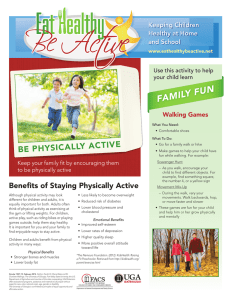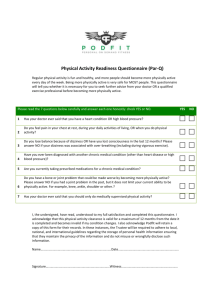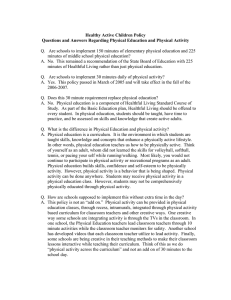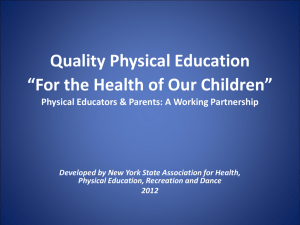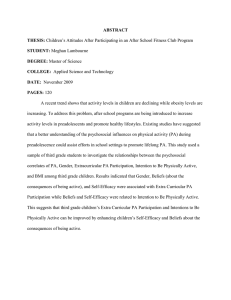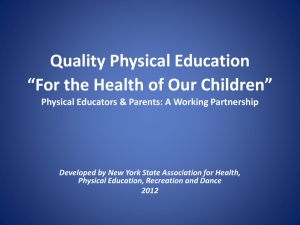POSITIVE PHYSICAL EDUCATION Herka Maya Jatmika PJKR FIK UNY
advertisement
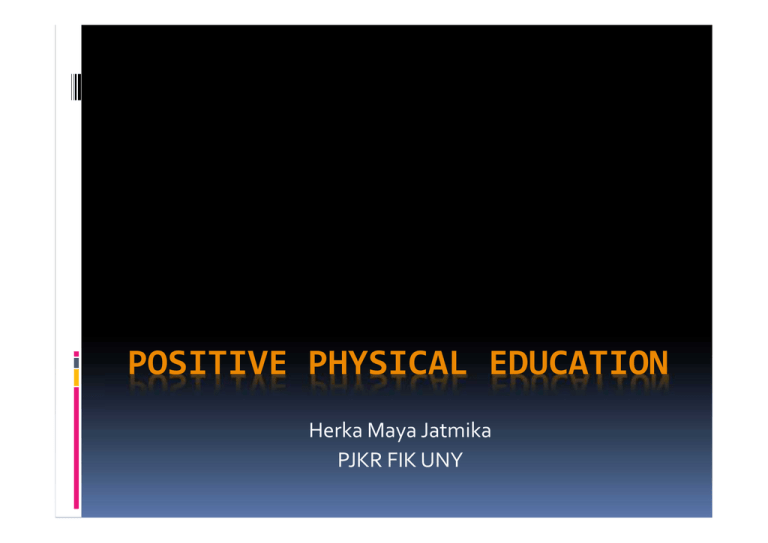
POSITIVE PHYSICAL EDUCATION Herka Maya Jatmika PJKR FIK UNY Disclaimer All physical education is not good physical education Goal of Physical Education To develop physically educated individuals who have the knowledge, skills, and confidence to enjoy a lifetime of healthful physical activity To guide youngsters in the process of becoming physically active for a lifetime Popular Terms to Describe “Good” Physical Education Quality physical education Positive physical education Positive (Quality) Physical Education Opportunity to learn Qualified teachers Adequate time Meaningful content National/state standards for physical education Appropriate instruction Formative and summative assessment Positive Physical Education Another term for quality physical education Focus is on creating a positive environment in which all students can be successful Recognition that enjoyment of physical activity is a major influence on whether a person chooses to be active Examples of Positive (Quality) Physical Education All children being active Stations Small group games Technology (pedometers, heart rate monitors) Choices Variety of activities Various practice levels Personal goals Cooperative Activities Definition of a Physically Educated Person HAS learned skills necessary to perform a variety of physical activities IS physically fit DOES participate regularly in physical activity KNOWS the implications of and the benefits from involvement in physical activities VALUES physical activity and its contribution to a healthful lifestyle Purpose of National Standards for Physical Education To define what a student should know and be able to do as a result of a quality physical education program Provides credibility to our profession as we are one of many disciplines with standards Physical Activity vs. Physical Education Physical activity = behavior Physical education = curricular area that teaches about physical activity (helps student attain the knowledge and skills; does not just provide an opportunity for students to be physically active) Students are physically active in physical education, but students are not (comprehensively) physically educated at recess or through sport participation Recognized Solutions Physical activity Physical education Physical Education’s Role in the Obesity Epidemic Physical inactivity is part of the problem Physical activity is part of the solution Physical education is a critical to increasing physical activity School physical education programs are the one place that: All children can participate in regular physical activity All children can become physically educated for a lifetime of physical activity National Call to Action: Increase Physical Activity Among Youth Healthy People 2010 (2000) Dietary Guidelines for Americans (2000) Promoting Better Health for Young People Through Physical Activity and Sports: A Report to the President from the Secretary of Health and Human Services and Secretary of Education (2000) The Surgeon General’s Call to Action To Prevent and Decrease Overweight and Obesity (2001) Guide to Community Preventive Services (2001) The Brain/Body Connection Research has not been conducted to conclusively demonstrate a link between physical activity and improved academic performance However, such a link might be expected Research does show that: Movement stimulates brain functioning Physical activity increases adolescents’ self-esteem and reduces anxiety and stress…thus, through it’s effects on mental health, may help increase students’ capacity for learning Increases in time for physical education did not lead to lower test scores Typical QuestionsYou May be Asked How much physical activity do children and adolescents need? What is the most important thing that schools can do to increase physical activity among children and adolescents? What are the biggest barriers for schools to provide quality physical education to all students? Can’t physical education be provided as part of recess? Why do schools have to take responsibility for the physical activity of students? Conclusion Schools need to educate the whole child Physical education is the only curricular subject that develops a child’s physical self Children deserve a comprehensive education It’s up to taxpayers and decision-makers to make this happen It’s up to us (and our partners) to influence taxpayers and decision-makers
